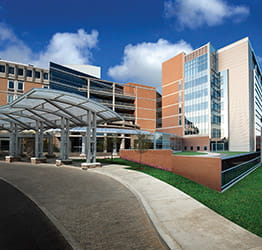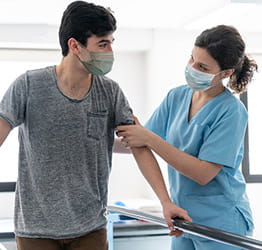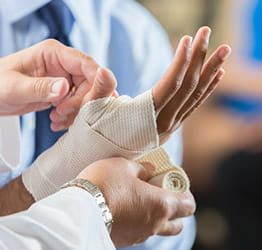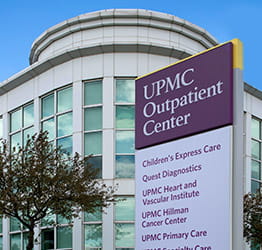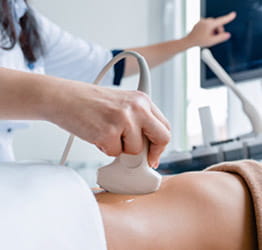What Is Radioactive Seed Localization (RSL)?
Radioactive seed localization (RSL) is a minimally invasive, image-guided procedure that is used prior to surgery to help surgeons precisely remove breast tumors or axillary lymph nodes that can’t be easily felt or seen.
A radioactive seed about the size of a grain of rice is placed in the area to be removed by a radiologist either on the day of or a few days before your surgery. During your surgery, your surgeon will use a special tool to locate the seed so they can precisely remove the area of concern.
What are the benefits of RSL?
Benefits of RSL include:
- Enhanced surgical planning and precision — Allows your surgeon to minimize scarring and spare healthy tissue.
- Pre-surgical implantation — Reduces the length of your surgery and improves scheduling convenience.
Conditions we treat with RSL
- Breast cancer.
- Lymph node disorders in your underarm area.
- Noncancerous breast tumors.
Why Would I Need RSL?
You may need RSL if you need surgery to remove an area of abnormal breast tissue or a concerning lymph node under your arm.
Who’s a candidate for RSL?
Your doctor will let you know if you are a candidate for RSL. You may be a candidate if you have been diagnosed with breast cancer or another type of noncancerous breast tumor that can’t be easily seen or felt.
Alternatives to RSL
- Wire localization procedure.
What Are the Risks and Complications of RSL?
Like all medical procedures, minimally invasive breast procedures have some minor risks, including:
- Bleeding — There is a small risk (less than 1 in 100) of developing a hematoma (a collection of blood under your skin) that is large enough to cause a lump you can feel. This will cause bruising and will eventually go away on its own.
- Bruising — A small amount of bruising is normal near the place where your RSL was inserted and may vary depending on the amount of bleeding you experience before and after your procedure. However, you should not have any redness at your procedure site.
- Infection — Infection is very uncommon, affecting less than 1 in 1,000 people after RSL procedures. Symptoms of infection include redness and warmth near the place where your RSL was inserted. If you have infection symptoms, you should contact the procedure center or your doctor right away.
RSL uses low-energy radiation that poses little risk to you or others. However, your doctor may recommend avoiding holding children on your lap while the seed is in place.
You should also let your doctor know if you are breastfeeding, pregnant, or think you might be pregnant.
What Should I Expect From RSL?
Before: How to prepare for RSL
You will have your RSL procedure the day of or 1-5 days before your scheduled breast surgery procedure. To prepare for the procedure, you should:
- Have your healthcare provider enter an order in the UPMC electronic medical record system or provide you with a written prescription to bring with you to the procedure.
- Stop taking aspirin, aspirin-containing products, and NSAIDs seven days before your biopsy. If you have questions or concerns, please contact the breast center for clarification. You may take acetaminophen one hour before your procedure to minimize discomfort.
- Contact your doctor if you are taking blood-thinning medication, such as Coumadin®, warfarin, heparin, Pradaxa®, or Plavix®, to find out if you can safely stop the medication before your biopsy procedure.
- Let your care team know if you are pregnant or think you might be pregnant.
- Tell your doctor if you are sensitive or allergic to any medications, iodine, latex, tape, or anesthetic agents (local and general).
- Let your care team know if you have a nickel allergy.
On the day of your procedure, arrive 30 minutes before your scheduled procedure time. Be sure to bring your photo ID and health insurance card(s).
You should wear a two-piece outfit (shirt and pants/shorts/skirt) and bring a sports bra with you if you have one. Wearing a supportive bra after your procedure can minimize breast movement and discomfort.
How long does RSL take?
Your RSL procedure will take about 30 minutes. However, you should plan to be at the breast center for up to two hours.
Is an RSL procedure painful?
You will receive an injection of local anesthesia to numb the procedure area, which will burn for about 15 seconds. You may feel mild pressure during your RSL procedure, but it should not be painful.
During your RSL
On the day of your RSL procedure, your doctor will explain the procedure to you and answer any questions you may have. After the seed is placed, doctors must remove it surgically.
After taking mammography or ultrasound images of your breast to confirm the location of the abnormal tissue, your radiologist will:
- Use an electronic device called a Geiger counter to measure radiation in the needle containing the radioactive seed to ensure it is working properly.
- Clean your skin and numb the procedure area by giving you an injection of local anesthesia. You will feel a burning sensation that will last for about 15 seconds while you receive the numbing medication. After the area is numb, you will feel some pressure during the procedure. You should not feel any pain.
- Insert the needle containing the radioactive seed into your breast using imaging guidance.
- Take more images to confirm the position of the needle.
- Push the seed out of the needle and into your tissue.
- Remove the needle, leaving the radioactive seed behind.
- Confirm that the radioactive seed is working properly by using the Geiger counter to check for radiation in the needle and in your breast.
- Take a mammogram image to confirm the placement of the seed and mark the location of the seed for your breast surgeon.
Is an RSL procedure painful?
Your doctor will numb your breast with a local anesthetic, so you shouldn’t feel any pain during your procedure. After your procedure, you may have some discomfort or bruising.
Recovery after RSL
The low radioactivity of the seed is not a hazard to you or others around you. You should be able to drive home after your procedure and resume normal activities within a few hours. However, you may notice some mild pain, discomfort, or bruising that should improve in a few days.
You will have your scheduled surgery within five days of your RSL procedure. Between seed placement and surgery, you can resume your normal activities. However, you should avoid holding an infant or young child to your breast for long periods of time while the seed is in place to reduce the risk of radiation exposure.
Surgical removal after RSL
During surgery, a special detector called a gamma probe is used to locate the seed. Since the seed is precisely placed in or next to the abnormal tissue, it helps guide your surgeon directly to the area that needs to be removed.
When you have surgery, the tissue and seed will be removed by the surgeon. A mammogram image will be taken of the specimen to confirm that the appropriate area of tissue and the seed have been removed. The tissue and seed will be sent to pathology for analysis.
When to call your doctor about complications
Call your doctor right away if you notice signs of infection or complications including:
- Excessive bleeding.
- Drainage from your incision site.
- Redness.
- Severe pain or pressure.
- Swelling.
- Warmth.
Why Choose UPMC for RSL?
When you choose UPMC for RSL, you will receive:
- Access to advanced imaging technology — Our experts use the latest imaging technology to quickly and accurately diagnose and treat a full range of health conditions.
- Convenient imaging services — Imaging appointments are available at multiple locations with hours that fit your schedule.
- Multidisciplinary care — We partner with breast surgeons, medical oncologists, radiation oncologists, breast reconstructive surgeons, and other medical experts to treat breast cancer and other breast conditions.
By UPMC Editorial Staff. Last reviewed on 2025-08-28.





